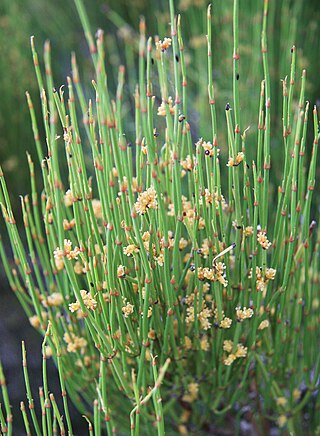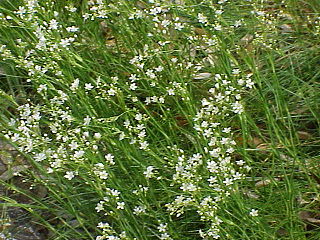
The Palearctic or Palaearctic is a biogeographic realm of the Earth, the largest of eight. Confined almost entirely to the Eastern Hemisphere, it stretches across all of Eurasia north of the foothills of the Himalayas, and North Africa.

Dactylorhiza is a genus of flowering plants in the orchid family Orchidaceae. Its species are commonly called marsh orchids or spotted orchids. Dactylorhiza were previously classified under Orchis, which has two round tubers.

Gagea is a large genus of spring flowers in the lily family. It is found primarily in Eurasia with a few species extending into North Africa and one species in North America.

Leymus is a genus of plants in the grass family Poaceae (Gramineae). It is widespread across Europe, Asia, and the Americas.

Sparganium (bur-reed) is a genus of flowering plants, described as a genus by Linnaeus in 1753. It is widespread in wet areas in temperate regions of both the Northern and Southern Hemispheres. The plants are perennial marsh plants that can grow to 3.5 m, with epicene flowers.

Ephedra is a genus of gymnosperm shrubs. The various species of Ephedra are widespread in many arid regions of the world, ranging across southwestern North America, southern Europe, northern Africa, southwest and central Asia, northern China, and western South America. It is the only extant genus in its family, Ephedraceae, and order, Ephedrales, and one of the three living members of the division Gnetophyta alongside Gnetum and Welwitschia.

Lycopus is a genus of herbaceous plants in the family Lamiaceae. The many species are known as water horehound, gypsywort, and bugleweed and are native to Europe, Asia, Australia, and North America. The species are most often found in wetlands, damp meadows, and stream banks. Some of the wetland species have become endangered.

Leonurus (motherwort) is a genus of flowering plants in the family Lamiaceae. It is native to Europe and Asia, naturalized in New Zealand, Hawaii, New Caledonia, and much of North and South America.

Neottia is a genus of orchids. The genus now includes the former genus Listera, commonly known as twayblades referring to the single pair of opposite leaves at the base of the flowering stem. The genus is native to temperate, subarctic and arctic regions across most of Europe, northern Asia, and North America, with a few species extending into subtropical regions in the Mediterranean, Indochina, the southeastern United States, etc.

Cruciata is a genus of flowering plants in the family Rubiaceae. It is found in Europe, northern Africa, and across southern and central Asia from Turkey to the western Himalaya and north to the Altay region of Siberia.

Ziziphora are a genus of annual or perennial herbs or subshrubs in the family Lamiaceae. Ziziphora has aromatic leaves; they are found in open and often xeric habitats in Southern and Eastern Europe, North-West Africa and Asia to the Himalayas and Altai Mountains.
Lagopsis is a genus of the mint family, first described in 1835. It is native to Siberia, China, Mongolia, and Central Asia.
- Lagopsis darwinianaPjak - Mongolia
- Lagopsis eriostachya(Benth.) Ikonn.-Gal. - Tuva, Irkutsk, Mongolia, Xinjiang, Qinghai
- Lagopsis flavaKar. & Kir. - Xinjiang, Kazakhstan, Kyrgyzstan
- Lagopsis marrubiastrum(Stephan) Ikonn.-Gal. - Altai Republic in Siberia, Ladakh Range of Tibet and Kashmir
- Lagopsis supina(Steph. ex Willd.) Ikonn.-Gal. - China, Mongolia, Siberia

Psammophiliella muralis is a species of flowering plants in the family Caryophyllaceae. It is known as annual gypsophila, cushion baby's-breath and low baby's-breath, an annual plant principally native to Europe except the British Isles. It can be also found in Central Asia, Turkey, the Caucasus, and Siberia. It is one of two species in genus Psammophiliella.

Eremogone saxatilis is a species of flowering plant belonging to the family Caryophyllaceae.

Bromus danthoniae, the oat brome or three-awned brome, is a species of flowering plant in the family Poaceae, native to Turkey, Cyprus, the Caucasus region, the Middle East, Central Asia, Afghanistan, Pakistan, the western Himalayas, and Tibet. It is rarely discovered growing in other locations, but apparently not in sustained populations. It grows in a wide variety of habitats, and shows morphological variation due to the differing conditions in those habitats.
Mesostemma is a genus of flowering plants belonging to the family Caryophyllaceae.

Ononis arvensis, the field restharrow, is a widespread species of flowering plant in the family Fabaceae, native to Eurasia from central Europe through to western Siberia and the western Himalayas. It is a perennial hemicryptophyte usually 50–100 cm (20–39 in) tall, typically found in meadows, but also in old fields and dry grasslands.
Dichodon is a genus of flowering plants in the carnation family, Caryophyllaceae. It includes seven species native to temperate and boreal Eurasia and Morocco, Greenland, and eastern Canada.














